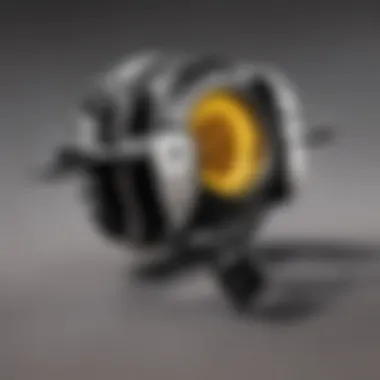Understanding Element TV Screws: A Complete Guide


Intro
Element TV screws play a crucial role in the assembly and functionality of modern televisions. Understanding these components helps both casual users and tech enthusiasts enhance their viewing experience. This guide aims to deliver a comprehensive overview that emphasizes the importance of these screws, their types, specifications, and best practices for installation and maintenance.
In television design, screws are not merely functional; they offer the necessary stability and structure. This content provides depth on various types of screws commonly used in Element TVs, along with insights into installation and maintenance practices. Knowledge of these components can assist in addressing common issues and contribute to a longer lifespan for your television.
The exploration will include practical advice based on real-life scenarios. You'll first learn about the types of screws used in Element TVs, followed by specifications that help you gauge which is suitable for different models. Lastly, we will dock into strategies for efficient handling and troubleshooting, ensuring your television operates optimally.
Whether your interest is rooted in securing your TV to a wall, replacing screws, or optimizing performance, this guide aims to enrich your understanding.
Types of Screws Used in Element TVs
Element TVs incorporate a variety of screws designed for different purposes. Here is a closer look:
- Mounting Screws: These screws connect the TV securely to any mounts, enabling an upright position.
- Back Panel Screws: These are essential for securing the back panel, as it houses critical electronics.
- Stand Screws: Used primarily for attaching the television stand, offering stability on a flat surface.
Each type possesses unique specifications which are ok to know. A hex screw might fit the stand, but a Philips screw is usually used for the back panel. Knowing the distinctions saves time in finding replacements and ensures proper fits.
Screw Specifications and Installations
Understanding the specifications of the screws is equally vital. Key factors to themselves consider include:
- Material: Commonly, screws are made from stainless steel or zinc-plated materials to resist corrosion.
- Length: Various sizes exist, with common lengths ranging from 10mm to 20mm, depending on the application.
- Head Type: This affects the tools you will need. Common types include flat-head, Phillips, and Torx.
Installing screws requires careful attention. Below are best practices you should follow:
- Use the right tools to avoid stripping screw heads.
- Ensure that you are matching screws to the correct openings given their paths in the design.
- Tighten screws by hand initially, then use a tool to finish.
Implementing these practices minimizes potential damages and avoidance from accidental loss.
Maintenance Practices for Managing Screws
Keeping screws managed leads to longevity. Recommendations include:
- Inspection: Regularly examine screws for wear and timeliness to avoid major pitfalls.
- Loosening and Retightening: Sometimes tightening can lead to premature wear, loosening and re-tightening is beneficial.
- Storing Replacements: Keeping a set of spare screws can deter interruptions during maintenance.
Remember this: Sne taking shortcuts with these elements in assembly can lead to severe consequences in performance later on.
"Screws may be small, but their role in functionality cannot be underestimated."
Troubleshooting Common Screw Issues
When issues arise during installation or maintenance, troubleshooting becomes key. Here are some effective strategies:
- Stripped Heads: If a screw's head gets stripped, use rubber bands for better grip or replace it entirely.
- Missing Screws: Reference your manufacturer manual to replace them quickly.
- Loose Screws: Consider re-tightening screws when noticing rattling or obstructions in performance.
Maintaining knowledge around different screw types and their importance helps ensure you are equipped alongside Element TV and its general upkeep strategy.
The insights provided here give all the necessary background to feeling equipped and knowledgeable about the Element TV screw purpose and use case, fostering a better televison interfction with secuirity and performance.
Prolusion to Element TV Screws
Overview of Element TVs
Element TVs have gained prominence due to their affordability and decent quality. These televisions serve various needs, from casual viewing to gaming setups. The brand focuses on providing a range of products that appeal to divers audiences while ensuring ease of use. Element TVs are designed for modern entertainment experiences, presenting a blend of usability and functionality.
Understanding the components of these televisions allows consumers to appreciate their design and operation better. Among these components, screws play a roles that is often overlooked.
Importance of Screws in Television Assembly


Screws are an essential structural element in TV assembly. They hold various parts together and provide the needed stability that allows for uninterrupted viewing. Each screw type is specifically chosen for its durability and performance. Improper handling or malfunction of screws might lead to a malfunction of the entire system.
Screws serve as unsung heroes in the construction of any television, directly impacting performance and longevity.
Furthermore, understanding screws can effectively improve maintenance practices. Knowing when to check and replace screws can extend the lifespan of an Element TV. Manufacturers consider different factors when choosing screws, including material compatibility and stress resistance. This detailed view is vital for anyone who wants to maximize their television functionality and longevity.
Types of Screws Used in Element TVs
Understanding the types of screws used in Element TVs is crucial. The quality and design of TVs depend on various components, and screws are fundamental to keeping everything together. They play a vital role in maintaining the structural integrity of Element TVs during operation. Knowing the specific screw types can aid users in various scenarios such as installation, maintenance, and troubleshooting.
Standard Screw Types
Element TVs primarily use standard screws for their assembly system. Utilization of these screw types is consistent across different model variants.
Common Standard Screw Types
- Phillips Screws: These are widely used, known for their cross-slot design that allows for efficient, secure fastening.
- Flat Head Screws: Often found in mounting brackets, they are essential for a flush finish against flat surfaces.
- Torx Screws: With a star shape, these screws provide a higher level of torque, making them ideal for securing panels and internal components.
Understanding these parameters is necessary, especially for those looking to replace or repair their television.
Specialized Screws
In addition to standard types, various specialized screws find application in Element TVs. These screws are engineered for specific functions and components within the unit, emphasizing the importance of selecting the right hardware.
Notable Specialized Screw Types
- Security Screws: Featuring designs that prevent easy removal, these screws are critical for safeguarding internal components.
- Self-Tapping Screws: These facilitate easier assembly by creating their own thread in materials, which is useful in thin panels and casings.
- Locking Screws: These are implemented where vibration can loosens fittings, ensuring that all components remain tightly fastened during operation.
In summary, recognizing the screw types used in Element TVs holds significance for every consumer. Failing to use the appropriate screws during installation or replacements might lead to complications such as hardware failure or worsen the user's TV experience.
Specifications of Element TV Screws
Understanding the specifications of Element TV screws is important for ensuring durable assembly and effective functionality within your television. Precision in screw specifications influences not just the physical attachment of components, but also the overall performance and lifespan of the television itself. Each TV screw plays a specific role, contributing to the stability and structural integrity of the entire assembly.
Dimensions and Measurements
The dimensions of Element TV screws are a critical aspect that must be given careful consideration. The length, diameter, and thread pitch can directly impact how well these screws fit various components. Incorrect dimensions might lead to loose connections, complicating the user's experience and potentially compromising the device’s safety. For instance, longer screws may extend too far and damage delicate components behind the screen, while shorter screws might not provide the necessary grip.
Key Measurements to Consider
- Length: Should be dimensionally compatible with free space and environment in TV assembly.
- Diameter: Vital to match predefined holes in mounting brackets.
- Thread Pitch: Affects how tightly the screw can fit into a pre-tapped hole.
Understanding these measurements helps in selecting the right screws for specific models, avoiding common fitment errors, and maintaining optimal performance.
Material Composition
The material used in making Element TV screws profoundly affects their durability and resistance to environmental conditions. Factors like strength, corrosion resistance, and thermal stability are influenced by the choice of material. Most screws tend to be made from metals such as steel, often treated with zinc plating to enhance their resistance to rust and wear.
Common Material Types
- Stainless Steel: Offers excellent corrosion resistance, ideal for environments with moisture.
- Zinc-plated Steel: Provides a balance of strength and corrosion protection, suitable for standard use cases.
- Aluminum: Lightweight but not as strong; good for mounting brackets that don’t bear much weight.
Selecting the correct material not only contributes to the long-term reliability of the television but also impacts its ability to withstand diverse environmental conditions.
Choosing high-quality screws designed specifically for your Element TV can significantly affect longevity and ease of use.
Overall, understanding both the dimensions and materials of Element TV screws allows for making informed decisions that enhance performance and longevity, reflecting thoughtful consideration in television assembly.
Installation Procedures for Element TVs


The installation procedures for Element TVs matter for ensuring a successful setup. Proper installation leads to optimal performance, longevity, and enhanced user experience. Each stage, from selecting proper tools to following a logical sequence, carries significance. Ignoring any detail might compromise the setup or even the lifespan of the television. Adhering to structured procedures helps to simplify the task and mitigate mistakes during setup.
Tools Required for Installation
The right tools make a drastic difference in the installation process. Aided by correct tools, you can complete the task more effectively and ensure an efficient setup. Here are essential tools used in Element TV installation:
- Screwdriver: A Phillips or flathead screwdriver is often needed for handling screws. Specific screw types will determine the screwdriver choice.
- Level: Ensures the TV is appropriately mounted, avert tilting or slanted installation.
- Stud Finder: Utilizing a stud finder assists in locating stable points for wall mounting.
- Measuring Tape: Important to make precise measurements for the TV’s height and placement.
- Pencil: Used to mark dimensions and positions clearly.
Consciously prepare a tray or container for screws. Keeping everything organized can avoid memorable search experiences in the middle of installation.
Step-by-Step Installation Process
The step-by-step installation process enhances clarity and allows methodical action. When synthesizing the procedure, every task introduces essential components. Here’s a clear path to properly install your Element TV:
- Determine Location: Decide on the setting for your TV. Make sure it provides a good viewing experience and has easy access to power outlets.
- Use the Stud Finder: Confirm the wall supports to hold the TV securely. Mark any studs that will guide the installation.
- Mark Dimensions: Using a measuring tape and pencil, plot the desired height and alignment.
- Attach Mounting Bracket: Depending on your TV model, attach the bracket to the rear of the TV and secure tightly with washers and screws.
- Prepare the Wall: Lift your TV or mount bracket while ensuring marked spots fit with the mounted screws or wall anchors.
- Level and Secure: Once in place, confirm it’s level and adjust as necessary. Permanently secure the TV to the wall.
- Test Functionality: Ease into the new setup and check functions like power and connections to devices.
This systematic approach greatly enhances the chances of installing your TV frame with precision. Each action builds upon the last, ensuring comprehensiveness and safety that promotes usage satisfaction.
Following a defined procedure can save time, reduce errors, and improve the overall quality of the installation.
Maintenance and Troubleshooting
Maintaining Element TV screws is crucial for ensuring the longevity of your television set and its overall performance. Proper maintenance not only helps to prevent problems but also contributes to the smooth functioning of your TV. Additionally, understanding troubleshooting can save time and avoid unnecessary expenses. This section will cover some common issues related to screws and best practices for their maintenance.
Common Issues Related to Screws
There are several common problems that can arise with screws in Element TVs. Recognizing these issues promptly can save users from further complications down the line.
- Loosening: One frequent issue is screws becoming loose due to vibrations or temperature fluctuations.
- Rust or Corrosion: Damp environments can lead to rust or corrosion, impacting screw integrity.
- Stripped Threads: Over-torquing screws can cause the threads to strip, rendering them useless.
If you encounter these issues, you may notice that your television stands unstable or shows signs of malfunction. For example, if screws are not securely fastened, the mounting frame may shift, detaching the screen or causing connectivity issues. Identifying the right moment to conduct interventions is key to maintaining a high-quality viewing experience.
Best Practices for Maintenance
Proper maintenance can significantly extend the life of the screws in your TV setup. Here are some effective strategies:
- Routine Checks: Inspect screws periodically to ensure they are tight and free from corrosion.
- Use the Correct Tools: Employ properly sized screwdrivers for tightening. Mismatched tools increase the risk of damage.
- Humidity Control: Keep your TV environment dry to avoid issues with corrosion. Consider using a dehumidifier.
- Avoid Over-tightening: Stop when the screw feels secure; excessive force can strip threads.
- Replacement as Needed: Always replace damaged or worn screws immediately to avoid bigger problems.
Regular maintenance plays a key role in preventing minor issues from evolving into major failures.
By adhering to these practices, users will maintain the functionality and safety of their Element TVs, facilitating a better viewing experience without interruption.
Replacing Element TV Screws
Replacing screws in Element TVs is a critical aspect to maintain the performance and integrity of the television unit. Over time, screws can become worn out or damaged from multiple assembling and disassembling processes. This weakening compromises the structural integrity of the TV and may affect its function and safety. Properly replacing screws can ensure longevity and improve overall performance. Understanding when and how to replace screws helps in avoiding potential damages or operational issues.
When to Replace Screws
There are specific circumstances when replacing screws becomes essential. Here are some factors to be aware of:
- Visual Damage: If you notice visible wear such as rust, warping, or snapping of screw heads. This is a clear indication it’s time for a replacement.
- Loose Fit: When screws no longer hold components tightly, and you observe movement, it suggests that the threads may be stripped, making them ineffective.
- Repeated Use: If screws have been frequently removed and reattached, there is a chance the threads lose grip. It is advisable to replace them to maintain tightness.
- Core Upgrades: Installing new hardware or upgrading parts often means refitting screws for optimized installation, ensuring that new parts align properly.
Regularly evaluate the screws on your television, especially if you regularly transport or mount it. Tending to these simple checks can prevent misuse and enhance security, ensuring a steady viewing experience.
Choosing the Right Replacement Screws
Selecting the correct replacement screws can seem daunting but is simplified with understanding the key points to consider:
- Specifications: Always refer to the TV manual or manufacturer guidelines for screw specifications. Incorrect sizes can lead to secure issues or damage.
- Material Quality: High-quality stainless steel is preferable for its resistance to rust and wear. It ensures durability even with normal wear over time.
- Thread Type and Length: Ensure that the thread configuration matches the original screws for a proper fit. Different parts may require various length.
- Sizing Tools: Investing in a screw gauge can help determine the precise size you need. Make certain measurements before restoring screws to the right place.


The integrity of your Element TV relies on quality replacements. Utilizing screws that do not fit, or are of lower material quality damaged right to the point, can lead to severe malfunctions and safety risks. Make sure to take hardware selection seriously for an ideal viewing experience.
Remember: An inch of prevention is worth more than a pound of cure. Replacing screws proactively will save you time and resources later.
Understanding Screw Compatibility
Screw compatibility is a pivotal aspect in maintaining and operating Element TVs. This section will illuminate why understanding the compatibility of screws with specific brands is essential for both professionals and casual users alike. Using the wrong type of screw can lead to severe implications on the functionality and durability of the television. Properly matched screws ensure optimal construction and reduce the potential for damage, subsequently extending the life of your device.
Compatibility with Other TV Brands
When encountering a situation that necessitates the use of replacement screws, it's essential to recognize that not all screws are created equal. Element TVs have unique specifications which, if not adhered to, could result in problems like misalignment or even potential hazards.
Several TV brands may use similar screw types, but dimension discrepancies exist even among standard categories. For example, a screw from a Samsung TV may fit superficially but can create lasting harm if it does not correspond to the technical specifications of the mounts and panels used in the Element TV.
Additionally, t-cons, main boards, and panel connections often have various categories of compatible screws. For those planning to mix and match from different brands, it is crucial to consult specific guides or community forums, such as Reddit, where many discuss their own experiences.
Factors Influencing Compatibility
Understanding elements affecting screw compatibility is vital. Here are a few core aspects to consider:
- Screw Type: The thread pattern, length, and head style all determine how well the screw performs with different materials involved in TV assembly.
- Material Softness: Softer material screws could become damaged if paired with harder materials, leading to issues in function.
- Torque Specifications: Each device can have precise torque measurements necessary during screw installation. Improper torque can strip the screw or damage components.
In summary, compatibility doesn't just hinge on broad categories; details matter, too. Keeping these factors in mind aids in ensuring safety and efficiency while handling TV hardware.
Incompatible screws can lead to malfunctioning displays and may cause irreversible damage to critical components.
To sum up, comprehending screw compatibility intertwines deeply with appreciating both the practicality and safety regulations involved in Element TV usage.
Safety Considerations
Safety considerations are essential when dealing with television assembly and, specifically, Element TV screws. Using appropriate safety measures helps protect both the user and the hardware. Adhering to best practices can prevent damage to the television itself, as well as ensure personal safety during installation and maintenance tasks.
Handling Hardware Safely
When handling Element TV screws, there are several simple strategies to enhance safety. First, prepare a clean, organized workspace. Clutter can lead to accidents, especially with small hardware that is easily misplaced. Second, wear safety goggles to protect your eyes from any debris or accidents. Third, avoid using damaged tools. A defective screwdriver can slip and cause injury or damage. Electronic discharges can also occur, so maintain grounding measures, especially in static-sensitive environments. Lastly, keep small components like screws out of the reach of children or pets, as they present choking hazards or other risks.
Impact of Incorrect Screw Usage
Using the wrong screws can have serious consequences. Misuse of screws may lead to weakened joints, which can cause structural failure in the television. For instance, using screws that are too long could penetrate important internal components, resulting in operational failure or irreparable damage. On the other hand, screws that are too short may not hold securely, leading to wobbling or even furniture hazards if the television falls. Over-torquing screws can cause stripping, rendering them useless. This emphasizes the importance of skillfully matching screws to their intended use, as proper installation is key to ensuring longevity and performance.
Always double-check the specifications before installation.
In summary, safety considerations, while sometimes overlooked, form a crucial element of working with Element TV screws. By adopting a careful approach and understanding the implications of incorrect usage, both users and technicians can enhance their safety and that of their equipment.
Future Trends in Television Hardware
The landscape of television hardware is continually advancing, with innovations in screw design and the broader role these screws play in evolving technologies. Understanding these future trends is essential for users and manufacturers alike. Proper hardware can greatly enhance user experience, affecting performance and durability of the device.
Innovations in Screw Design
Screw design has become increasingly sophisticated over the years. Modern engineering now emphasizes unique lock mechanisms, enhanced materials, and some screws integrate advanced features. For example, many screws are being constructed with materials that resist corrosion, ensuring longevity. Designs are sometimes unique in shape or specific to installation sectors, like using privacy screws in screens showing sensitive information.
Benefits of these innovations include:
- Enhanced Security: Customized screws can improve in devices meant for high security.
- User-Friendly Design: Some designs allow for simpler tools to be used, reducing misinstallation instances.
- Weight Distribution: Depending on the shape and structure of screw, this can enhance how components relate in their assembly.
Staying ahead of these advancements is crucial, particularly for toolbox essentials as they relate to new TV models and features implemented in them.
The Role of Screws in Evolving Technologies
Screws, though often overlooked, play pivotal roles in diverse technological progressions. As televisions become slimmer and feature more complex designs, screws become critical for structural integrity.
- Integration with Smart Technology: As televisions shift towards smart functions, mounting elements, like screws, have to accommodate not just physical support, but data connectivity lines in certain cases like server rack integration for complex media setups.
- Evolving Materials: The use of light-weight and durable materials in screws impacts the overall efficiency of the installation. This improves heat dissipation in screens while maintaining structural support where it is most needed.
The foresight in the application of screws is as necessary as their immediate functionality. Understanding developments in screw design and their roles within hardware will continue to matter as televisions become vital in advanced tech leveraging.



